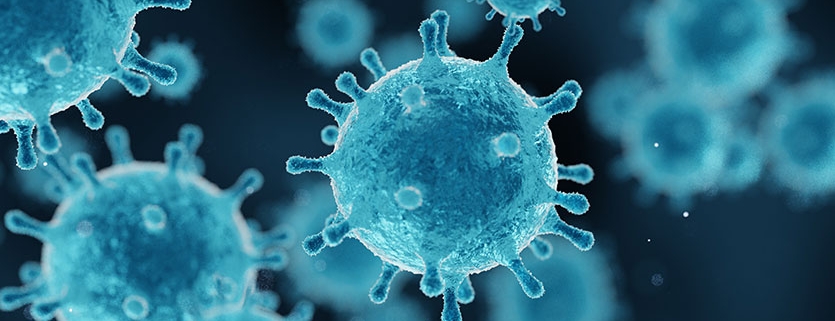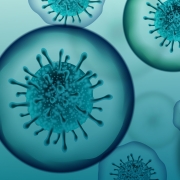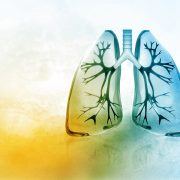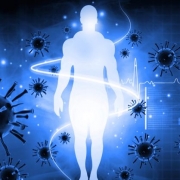Answers to Common Questions About How Viruses Work

Editor’s Note: The following story is focused on viruses, in general. Though a few common viruses are used as examples, this is not meant to be a deep exploration of specific strains or a tool for diagnosis or treatment of any specific virus.
Viruses are little germs that can have big impacts on your health. Informing yourself about how viruses work helps you understand part of what your immune system deals with daily.
Start with some answers to common virus questions to boost your knowledge about what they do, how they work, and the way they can possibly be harmful. You’ll find out the basics about viruses, how your body responds to them, and the way herd immunity to viruses works.
Question: How are viruses and bacteria different?
Answer: The two kinds of microbes that most frequently make you sick are viruses and bacteria. Both are microscopic and trigger an immune system response. But viruses and bacteria could not be more different.
Let’s start with bacteria. These single-celled living organisms have a cellular membrane. They thrive in a wide temperature range, meaning you can find them almost everywhere. Bacteria have circular DNA that they use to reproduce. They feed on organic and inorganic matter, decaying plant and animal cells, even the food you eat. Some bacteria can even photosynthesize just like plants do.
Bacteria aren’t always bad. They can be beneficial to your body, too. In fact, the majority of bacteria aren’t harmful at all. Your skin and gut are teaming with bacteria, which you might know better as your microbiome. The microbes that live on your skin help clear away dirt and dead skin cells. In your intestines, bacteria help digest your food.
Some bacteria can be harmful, especially when they grow in places they shouldn’t. That’s why, generally, bacterial infections affect localized areas of the body. This can irritate or damage healthy tissue. Examples of common bacterial infections are strep throat, food poisoning, and ulcers.
To help battle bacterial infections, your doctor might recommend antibiotics. This kind of medicine kills the bacteria making you sick and disrupts its reproduction so it can’t spread.
Viruses are much smaller than bacteria and are not considered living organisms. They are infectious agents with only a protein shell and a strand of RNA or DNA, depending on the type of virus. They do not reproduce on their own—like bacteria do. Instead, viruses need a host cell to do the reproducing for them (you’ll learn more about that below.)
While bacteria can be either harmful or beneficial, most viruses only make you sick. Some common viruses are rhinovirus (common cold), varicella (chicken pox), and herpes (cold sore). Viral infections cause symptoms throughout the entire body, like congestion, aches, cough, and fatigue.
Antibiotics do not work against viruses. Instead, you must rely on your immune system. Over time, your immune system will develop antibodies to recognize the virus and prevent it from infecting healthy cells. This is why it pays to practice healthy habits on a consistent basis to help maintain your immune health.
Some viruses can be prevented through vaccination. Vaccines can help your body create antibodies before you’re ever exposed to the virus in your daily life. This way your body will be ready to fight off the specific virus if it ever comes along.
Question: How do viruses work in your body?
Answer: Since viruses are not alive, they rely on host cells to complete their lifecycle. They act like parasites—infecting healthy cells, using them to reproduce, and destroy them when they are done.
Viruses are tiny packages of DNA or RNA (genetic material) that travel in a protein shell. They are masters of disguise, so the protein coat of a virus is often mistaken by the cells in your body as a nutrient. Healthy cells are fooled into attaching to viruses with their receptor proteins. Then the virus enters the cell.
Once inside the host cell, the virus can release its genetic information. Viruses need to make copies of genetic material to reproduce. So, they hijack the cell’s own reproduction system. Now the host cell is making copies of the virus DNA or RNA, instead of the cell’s own genetic material.
After the virus reproduces in the cell, it breaks free, destroying the host cell in the process. The virus uses the membrane of the host cell to travel through the body undetected by the immune system. This is why it is difficult to treat viruses. They are hard for the immune system to identify and target.
Your body eventually learns to tell the difference between viruses and healthy cells. When it does, your immune system creates antibodies. These little proteins mark the virus. Antibodies lead immune-system agents like white blood cells to the virus so your defense team can wipe them out—along with the affected cells.
Question: What are symptoms?
Answer: Symptoms are the physical signals your body creates to tell you something is wrong. They alert you to possible infection by a bacteria or virus. Symptoms improve over time as your immune system eliminates the infection from your body.
Most symptoms are triggered by germs that irritate healthy cells. They can cause a sore throat, stimulate mucus production, and raise your body temperature. But the symptoms you experience when you’re sick can actually help your body fight the infection. See how your immune system works with symptoms to protect you from germs.
- Fever: Infections trigger an increase in body temperature. A fever is uncomfortable, but it’s a strategy your immune system uses to kill viruses. Some germs have a hard time living in high temperatures, so a fever makes your body a difficult place for a virus to survive.
- Runny nose: When the mucous membranes lining your nasal passages are injured by a virus, you experience a runny nose. That’s because your body produces a lot of mucous to trap the germs and flush them out. A runny nose is a sign your immune system is working hard to push back against an infection.
- Coughing: Your respiratory system has a reflex that expels germs from your body. If the cells in your airway detect an invader, they can trigger a cough. Forcibly coughing removes dust, bacteria, and viruses from your throat and lungs. Coughing also helps you remove excess mucous from your nose and throat.
- Sneezing: Just like coughing, sneezing is a reflex. It’s a powerful immune response that kicks germs out of your nose—fast.
Question: Why do different people experience different symptoms?
Answer: The symptoms that follow an infection aren’t the same for everybody. Genetics has a lot to do with how your body handles sickness. And since no two people have the same genes, everyone responds to germs differently.
Your genes influence how your immune system fights viruses and bacteria. Immunity begins in the womb with antibodies to germs inherited from your mother (called passive immunity which is temporary for a newborn). Information from every illness you get is stored in your genes so your immune system can adapt. That way you can produce antibodies to mark infections in the future.
So, when you experience symptoms from an infection, your genes likely haven’t encountered the germ before. If someone else has already developed an immune response to that infection, they may never manifest symptoms.
Lifestyle is another factor that can affect how different people experience symptoms—especially smoking. When it comes to colds, most people’s symptoms recede fairly quickly. Non-smokers will experience minor coughing and congestion that resolves over time.
But smokers can have a different experience. Smoking damages the cells lining the nose, throat, and lungs. And it significantly weakens the body’s immune response. The damaged tissue takes longer to repair, which make symptoms like coughing and congestion last longer. That’s why it can be very difficult to overcome a cold if you’re a smoker.
Question: Can treating the symptoms of an illness prolong the infection?
Answer: The jury is still out on this one. In most cases, there isn’t much evidence to suggest that treating the symptoms of an illness make it last any longer.
Some more serious viral infections (like the flu) can take a while to clear up. That doesn’t have to do with the medications you use to treat them. Unfortunately, it takes even the best immune systems time to kick the flu.
Symptoms like congestion and a cough grow old quickly. So, it’s reasonable to seek relief. You can feel better quickly with decongestants that help clear your nose and throat or a cough suppressant. These kinds of treatments don’t directly interfere with your immune response.
Some infections require more potent medication. Bacterial infections like strep throat need antibiotics to kill the bacteria making you sick. These medicines shorten the life of the infection, and help you feel better, too. They target the source of the infection (the bacteria) and eliminate it from your body.
In the case of steroid medications, you might notice an increase in the time you spend sick. Steroids treat inflammation, which can sometimes be caused by an infection in the body. This represents a temporarily suppression of your normal immune response, which can make the infection causing the inflammation to last a little while longer. They are used on a case-by-case basis, depending on the infection.
Question: When is it necessary to treat a fever?
Answer: If you’re sick with a fever, you might be better off letting it run its course. Using fever-reducing medicine might make sense short term. But in the long run, you hinder your body’s natural reaction to infection.
Fevers happen when your body temperature increases to slow the spread of a virus or bacteria. Germs thrive at normal body temperature. So, cranking up the heat is a good way to force them out. Reducing your fever makes your body a more hospitable environment for the pathogens that make you sick.
The general recommendation is that if your fever is low-grade (under 101° F/38.3° C for children, and below 103° F/39.4° C for adults) try to hold off on the fever reducers. Let your body do its thing to fight off an infection. Should your fever climb higher, contact your doctor. They will instruct you on which fever-reducing medications to use.
If your feverish child stops drinking fluids, appears listless and won’t make eye contact with you, contact your doctor immediately.
Question: Can you catch the same virus more than once?
Answer: Yes and no. Viruses are prolific and have many subtypes and species. While you can have the same type of virus multiple times, you may only feel sick when you encounter a new strain or subtype.
Rhinovirus, the kind of virus that causes common colds, has hundreds of unique subtypes and strains. Every time you come down with a cold, your immune system is fighting the specific strain that made you sick. And at the same time, you’re developing antibodies to mark that subtype of the rhinovirus.
Should you come in contact with the same strain of cold virus again, antibodies will tell your immune system to tackle the virus. However, if it’s a new version of the virus, then you could be out of luck.
Viruses are constantly mutating as a means of survival. Like parasites, their goal is to take over host cells and use the host DNA to reproduce. As soon as your immune system learns to block a virus, another version can pop up that may go undetected. This ability means you could get sick with the same kind of virus again.
Question: How does the immune system communicate to coordinate responses to viruses?
Answer: Constant cellular communication is a key to maintaining your overall health. And your immune system is no different.
Let’s start with the basics of immune system communication and its two main forms—direct receptor contact and messenger proteins.
Direct Receptor Contact
Like most cellular communication, your immune system’s ability to talk relies on receptors. These special sites on the outside of a cell make it possible to receive chemical signals and messenger proteins. They also allow cell-to-cell connection where transfer of information is possible.
Your immune cells have different receptors. T cells (an immune cell that matures inside the thymus) use their special receptors—aptly named T cell receptors—to gather information from infected cells. This is what allows other immune defenders to identify a potential pathogen.
Receptors are so critical to T-cell function that they’re classified by the receptors presented. T cells with a CD4 receptor are helpers, used to marshal your immune forces. CD8 receptors are a hallmark of the cytotoxic T cells doing the work of neutralizing infected cells.
These different T cells seek out and connect to specific receptors on infected cells. Depending on the type of major histocompatibility complex (a receptor on an infected cell), a helper or cytotoxic T cell links up. So, the receptor type and the resulting connection drives an important element of immune system communication.
Messenger Proteins
Direct contact isn’t always necessary or possible for a coordinated immune response, though. That’s why your immune system also talks amongst itself using special proteins called cytokines.
Immune messenger proteins can travel long or short distances, but signal different actions. Some cytokines act as a green light for a variety of immune-system responses. Others—called chemokines—are flashing beacons to recruit and guide more immune cells to a situation.
Interferons are immune-system-communication molecules sent out by a variety of cells involved in an infection. Infected cells—both immune and regular bodily cells—sent out unique versions of these proteins. The immune cells rushing to respond do, too. While specific in form and function, interferons generally boost the number of T-cell-binding receptors to help flag infected cells and guide your immune response.
This is, by no means, a comprehensive guide to your immune system’s complex language. But it’s a start. And it better helps you understand how these forms of communication combine to coordinate the flurry of immune activity when your body senses an invasion. That’s important for an effective, efficient response.
References
https://www.webmd.com/a-to-z-guides/qa/how-do-viruses-differ-from-bacteria
https://www.researchgate.net/publication/314214838_Difference_Between_Bacteria_and_Virus#pf5
https://askabiologist.asu.edu/virus
https://www.mayoclinic.org/diseases-conditions/infectious-diseases/symptoms-causes/syc-20351173
https://www.nytimes.com/2018/03/09/well/live/can-i-catch-the-same-cold-twice.html
https://www.healthline.com/health/bacterial-vs-viral-infections
https://www.webmd.com/cold-and-flu/cold-guide/cold-medicine-treatment-when-what-how#1
https://my.clevelandclinic.org/health/symptoms/17660-runny-nose/care-and-treatment
https://www.mayoclinic.org/diseases-conditions/fever/symptoms-causes/syc-20352759
https://www.livescience.com/63552-cold-virus-defense-tradeoff.html
https://my.clevelandclinic.org/health/drugs/4812-corticosteroids
https://www.scientificamerican.com/article/how-gut-bacteria-tell-their-hosts-what-to-eat/
https://www.mayoclinic.org/diseases-conditions/fever/symptoms-causes/syc-20352759
https://sciencing.com/differentiating-rna-dna-viruses-4853.html
https://www.ncbi.nlm.nih.gov/books/NBK21523/
https://pubmed.ncbi.nlm.nih.gov/23278741/
https://sciencing.com/communication-between-two-immune-system-cells-12731203.html














